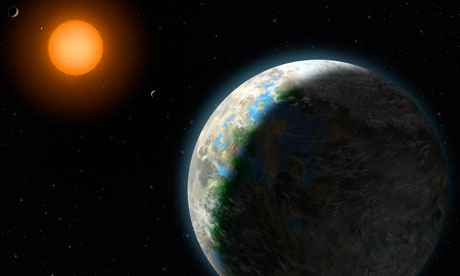太空探索研究人员最近发现了一颗大小类似地球的行星,这颗行星围绕离地球20光年的一颗恒星运转,其表面温度适宜产生液态水源,因而很有可能是另一个适合生物存活的星球。据研究人员介绍,这颗被命名为Gliese 581g的行星是已发现的围绕红矮星Gliese 581运转的六颗行星之一,也是这其中唯一一颗位于“可居住区”的行星。研究人员称,这颗行星很可能是一颗岩石行星,具有足够的引力维持稳定的大气层,而且它总是始终保持一面朝向恒星,使其一侧永久处于阳光之中,而另一侧永久在黑暗之中;这种特征有助于稳定行星的表面气候,而黑暗和阳光的交界处则是最适宜生物生存的区域。

 |
|
An artist's impression of Gliese 581g, which astronomers say is near Earth - relatively speaking - at 120 trillion miles.(Agencies) |
Astronomers have discovered a potentially habitable planet of similar size to Earth in orbit around a nearby star.
A team of planet hunters spotted the alien world circling a red dwarf star called Gliese 581, 20 light years away.
The planet is in the "Goldilocks zone" of space around a star where surface temperatures are neither too hot nor too cold for liquid water to form.
"Our findings offer a very compelling case for a potentially habitable planet," said Steven Vogt, an astronomer at the University of California, Santa Cruz. "The fact that we were able to detect this planet so quickly and so nearby tells us that planets like this must be really common."
If confirmed, the planet would be the most Earth-like that has ever been discovered in another solar system and the first strong contender for a habitable one.
More than 400 exoplanets have been discovered by astronomers, but most are gas giants, like Jupiter, that would be inhospitable to life as we know it.
Astronomers used the Keck telescope in Hawaii to study the movement of Gliese 581 in exquisite detail and from their observations inferred the presence of a number of orbiting planets. The team report two new planets in the Astrophysical Journal, bringing the total number known to be circling the star to six.
One of the planets, named Gliese 581g, has a mass of three to four times that of Earth and takes 37 days to orbit the star. Astronomers believe it is a rocky planet with enough gravity to retain an atmosphere.
Unlike the previously discovered planets, Gliese 581g lies squarely in the region of space where life can thrive. "We had planets on both sides of the habitable zone — one too hot and one too cold — and now we have one in the middle that's just right," Vogt said.
One side of the planet is always facing the star, much as one side of the moon constantly faces Earth. This means that the far side of the planet is constantly in darkness. The most habitable region of the planet would be the line between the light and dark regions.
"Any emerging life forms would have a wide range of stable climates to choose from and to evolve around, depending on their longitude," Vogt said.
The average temperature on the planet is estimated to be between -31 to -12C, but the ground temperature would vary from blazing hot on the bright side and freezing on the dark side.
"The number of systems with potentially habitable planets is probably on the order of 10 or 20 percent, and when you multiply that by the hundreds of billions of stars in the Milky Way, that's a large number. There could be tens of billions of these systems in our galaxy," said Vogt.
相关阅读
(Agencies)

Vocabulary:
Goldilocks zone: Also called the habitable zone or life zone, the Goldilocks Zone is an area of space in which a planet is just the right distance from its home star so that its surface is neither too hot nor too cold. That means that the planet could possibly host liquid water. 可居住区,指与运转轨道中心的恒星距离适当,表面温度不冷也不热,能够保持液态水的区域。
(中国日报网英语点津 Helen 编辑)